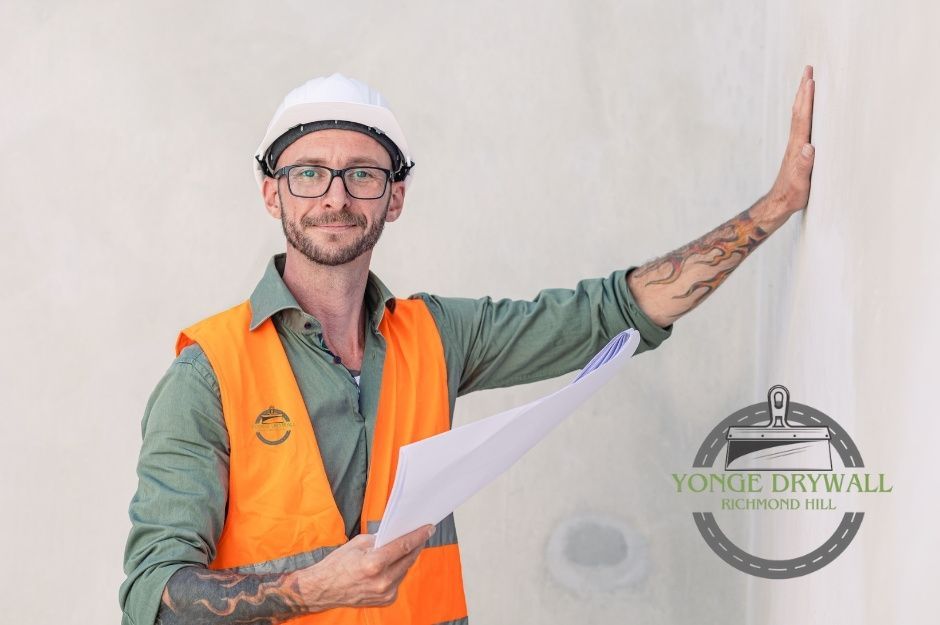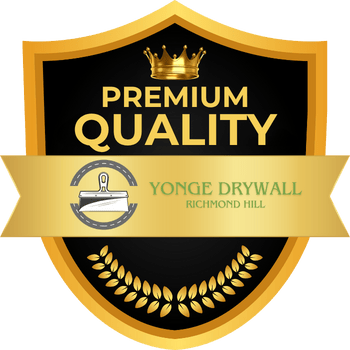Drywall Repair Pickering
Top-Quality Drywall Repair Service Company in Pickering, Ontario

Drywall damage can significantly impact your home's appearance and structural integrity, making professional repair services essential for Pickering homeowners. Professional drywall services at Yonge Drywall Richmond Hill in Pickering encompass everything from minor crack repairs and hole patching to complete panel replacement and specialized soundproof installations.
Serving a community of over 99,000 residents across 231 square kilometres in Durham Region, whether you're dealing with unsightly ceiling cracks, outdated popcorn textures, water damage, or holes from everyday wear and tear, the right drywall company can restore your walls and ceilings to pristine condition.
These comprehensive solutions address common issues like sagging drywall, water damage restoration, and the removal of dated popcorn ceilings that can modernize your living space. Properties throughout neighborhoods like Bay Ridges, Rosebank, West Shore, and the growing Seaton community require expert drywall services to maintain their value and appearance.
The quality of drywall finishing work directly affects the final appearance of your walls and ceilings. Expert services include precise mudding, taping, and texturing techniques that create seamless surfaces ready for painting or other decorative treatments, ensuring your investment enhances both your property's value and visual appeal.

Yonge Drywall Richmond Hill (HP)

Comprehensive Drywall Repair Services in Pickering, Ontario
Professional drywall repair services address structural issues from minor ceiling cracks to extensive water damage restoration. From the suburban developments around Frenchman's Bay to historic homes in rural communities like Whitevale, Brougham, and Claremont, expert contractors handle everything from precise hole patching to complex sagging wall repairs using specialized techniques and materials.
Ceiling Crack Repair
Ceiling cracks develop from house settling, temperature changes, or structural movement. Small hairline cracks require different repair methods than wide gaps or recurring splits. Pickering's elevation of 89 metres (292 feet) and proximity to Lake Ontario can contribute to seasonal temperature fluctuations that cause ceiling stress and cracking in local homes.
Professional repair begins with crack assessment to determine the underlying cause. Surface cracks need mesh tape and compound application, while deeper fissures require structural reinforcement.
Common ceiling crack types:
- Hairline stress cracks
- Corner separation cracks
- Sagging-related splits
- Settlement cracks
The repair process involves cleaning debris, applying mesh tape, and layering joint compound. Multiple coats ensure smooth blending with existing ceiling texture.
Proper priming and painting complete the restoration. Quality drywall repair eliminates visible crack lines and prevents future splitting in the same location.
Hole Patching and Wall Restoration
Wall holes range from small nail punctures to large openings from accidents or renovations. Each size category requires specific patching techniques and materials for lasting repairs. Properties in Pickering's urban core near the City Centre and Duffin Heights neighborhoods, as well as heritage homes in communities established in the 1700s and 1800s, require specialized hole patching that respects both modern and historical construction methods.
Small holes under two inches use mesh patches or self-adhesive repair kits. Medium holes need backing material like mesh or wood supports before compound application.
Large holes require cutting drywall pieces to fit the opening exactly. Professional installers measure precisely and secure new sections with screws before taping seams.
Hole repair materials:
- Mesh patches for small holes
- Backing boards for medium damage
- New drywall sections for large openings
- Joint compound for all sizes
Wall repairs include texture matching to blend seamlessly with surrounding surfaces. Skilled contractors recreate orange peel, knockdown, or smooth finishes perfectly.
Water Damage Solutions
Water damage creates multiple drywall problems including staining, softening, warping, and mold growth. Quick response prevents extensive structural damage and costly replacements. Pickering properties near Frenchman's Bay, along Duffins Creek and Carruthers Creek watersheds, or in proximity to the Pickering Nuclear Generating Station require vigilant moisture monitoring and rapid water damage response.
Moisture assessment determines repair scope and identifies affected areas beyond visible damage. Wet drywall often requires complete removal to prevent mold development.
Replacement sections must match existing thickness and type exactly. Fire-rated or moisture-resistant drywall may be necessary depending on location and building codes. Properties in Pickering's Brock Industrial area or near commercial zones may require specialized fire-rated drywall to meet Durham Region building code requirements.
Water damage repair steps:
- Moisture testing and assessment
- Damaged section removal
- Structural drying and treatment
- New drywall installation
- Seam taping and finishing
Professional contractors address underlying moisture sources before completing repairs. This prevents recurring damage and ensures long-term durability of your drywall repairs.
Sagging and Structural Issues
Sagging drywall indicates fastener failure, inadequate support, or structural movement. This serious condition requires immediate attention to prevent complete panel failure. Homes built during Pickering's post-World War II suburban expansion, particularly subdivisions constructed near Frenchman's Bay in the 1940s-1960s, may experience age-related sagging that requires professional assessment.
Loose screws or nails lose holding power over time, especially with temperature fluctuations. Additional fasteners installed at proper intervals restore secure attachment to framing members.
Severe sagging may require complete panel replacement if the drywall has stretched or cracked extensively. New installation includes proper fastener spacing and support reinforcement.
Structural repairs often involve adding blocking between studs or joists for additional support. This prevents future sagging and ensures code compliance for your wall repair project.
Professional assessment identifies whether repair or replacement provides the most cost-effective solution for sagging drywall problems.
Specialized Ceiling Treatments
Ceiling damage requires specific expertise and techniques that differ from standard wall repairs. Professional drywall companies in Pickering handle complex ceiling issues including outdated textures and damaged panels. Properties throughout neighborhoods accessible via Durham Regional Roads and near Highway 401 corridors benefit from experienced contractors familiar with local construction standards.
Popcorn Ceiling Removal
Popcorn ceilings create dust collection problems and make rooms appear dated. Professional removal requires proper containment and safety equipment to prevent mess throughout your home.
The removal process begins with plastic sheeting to protect furniture and floors. Contractors spray the ceiling with water to soften the texture before scraping it away with specialized tools.
Safety considerations include potential asbestos testing for homes built before 1980. Given that Pickering experienced significant development following the 1770s British settlement and major suburban expansion after 1945, many properties require asbestos testing before popcorn ceiling removal. Licensed professionals handle hazardous materials according to local regulations.
After texture removal, your ceiling receives skim coating to create a smooth surface. This drywall repair step fills any gouges or imperfections left from the scraping process.
The final step involves sanding and priming before applying your chosen finish. Most homeowners select smooth or lightly textured surfaces for modern appeal.
Replacing Ceiling Panels
Water damage and structural issues often require complete panel replacement rather than patching. Professional drywall installation ensures proper support and seamless integration with existing surfaces.
Contractors remove damaged sections by cutting along ceiling joists for clean edges. New drywall panels match the existing thickness, typically 1/2 inch for residential ceilings.
Installation steps include:
- Measuring and cutting replacement panels
- Securing to ceiling joists with appropriate screws
- Applying joint compound and tape to seams
- Texturing to match surrounding areas
Heavy panels require proper lifting equipment and multiple technicians for safe installation. Professional crews prevent sagging by using adequate fasteners spaced correctly along support structures.
Professional Drywall Installation Options
Professional drywall installation services in Pickering provide specialized solutions beyond standard wall construction. Soundproof drywall systems offer enhanced acoustic control for residential and commercial properties. With the city's proximity to Highway 401 and Highway 407 ETR, as well as the Pickering GO station connecting residents to Toronto's downtown core via public rail transit, soundproofing has become increasingly important for homes near major transportation corridors.
Soundproof Drywall Installation
Soundproof drywall installation uses specialized materials and techniques to reduce noise transmission between rooms. These systems typically incorporate multiple layers of acoustic-rated drywall with sound-dampening compounds. Properties in Pickering's Rougemount, Woodlands, and Dunbarton neighborhoods benefit from soundproofing solutions, particularly homes near the city's transportation infrastructure and the Pickering Casino Resort complex.
The installation process involves applying acoustic sealant around all edges and penetrations. Contractors use staggered stud patterns or resilient channels to decouple the drywall from structural elements.
Key soundproof drywall features:
- Mass-loaded vinyl barriers
- Acoustic-rated drywall panels
- Sound-dampening adhesives
- Resilient mounting systems
Professional installers measure decibel reduction levels to ensure optimal performance. The thickness ranges from standard ½-inch to specialized multi-layer systems exceeding 1 inch.
Proper installation requires sealing all gaps and joints with acoustic caulk. This prevents sound leakage that compromises the system's effectiveness.
Expert Drywall Finishing Services
Professional drywall finishing transforms rough wall surfaces into smooth, paint-ready surfaces through precise texturing techniques and multi-layer mudding and taping processes. These specialized services ensure your walls achieve a uniform appearance that enhances the overall quality of your interior spaces. Whether you're renovating a historic property in Whitevale (featured in television shows like Hannibal, Suits, and American Gods since the 1980s) or updating a modern condo in Pickering's growing high-rise developments, expert finishing ensures professional results.
Drywall Texturing
Drywall texturing adds visual interest and depth to your walls while helping to conceal minor imperfections in the surface. Professional contractors apply various texture patterns including knockdown, orange peel, and smooth finishes.
The texturing process begins after your drywall repairs are complete and the surface is properly prepared. Contractors use specialized spray equipment or hand tools to create consistent patterns across your walls.
Common texture types include:
- Orange peel texture for subtle visual appeal
- Knockdown texture for modern residential spaces
- Smooth finish for contemporary designs
- Sand texture for traditional applications
Your choice of texture affects both the appearance and maintenance requirements of your walls. Orange peel and knockdown textures help hide future nail holes and minor wall damage better than smooth finishes.
Mudding and Taping
Mudding and taping create seamless joints between drywall panels and prepare surfaces for painting or texturing. This multi-step process requires precision and proper drying time between coats. Pickering's location immediately east of Toronto in Southern Ontario means contractors must account for regional humidity levels and seasonal temperature variations that affect drying times and compound application.
The taping process starts with paper or mesh tape applied over drywall seams. Contractors then apply joint compound in three successive coats, with each layer extending wider than the previous one.
The standard process includes:
- First coat covers the tape completely
- Second coat feathers edges for smooth transitions
- Third coat creates the final smooth finish
- Sanding removes imperfections between coats
Proper mudding and taping prevents visible seams and creates a uniform surface for your final finish. Professional contractors ensure corners remain sharp and joints stay invisible after painting. For residents in the rapidly developing Seaton area, where only 1,549 of 20,989 planned units had been built as of 2022, quality finishing work ensures new construction meets the highest standards for this growing community.
